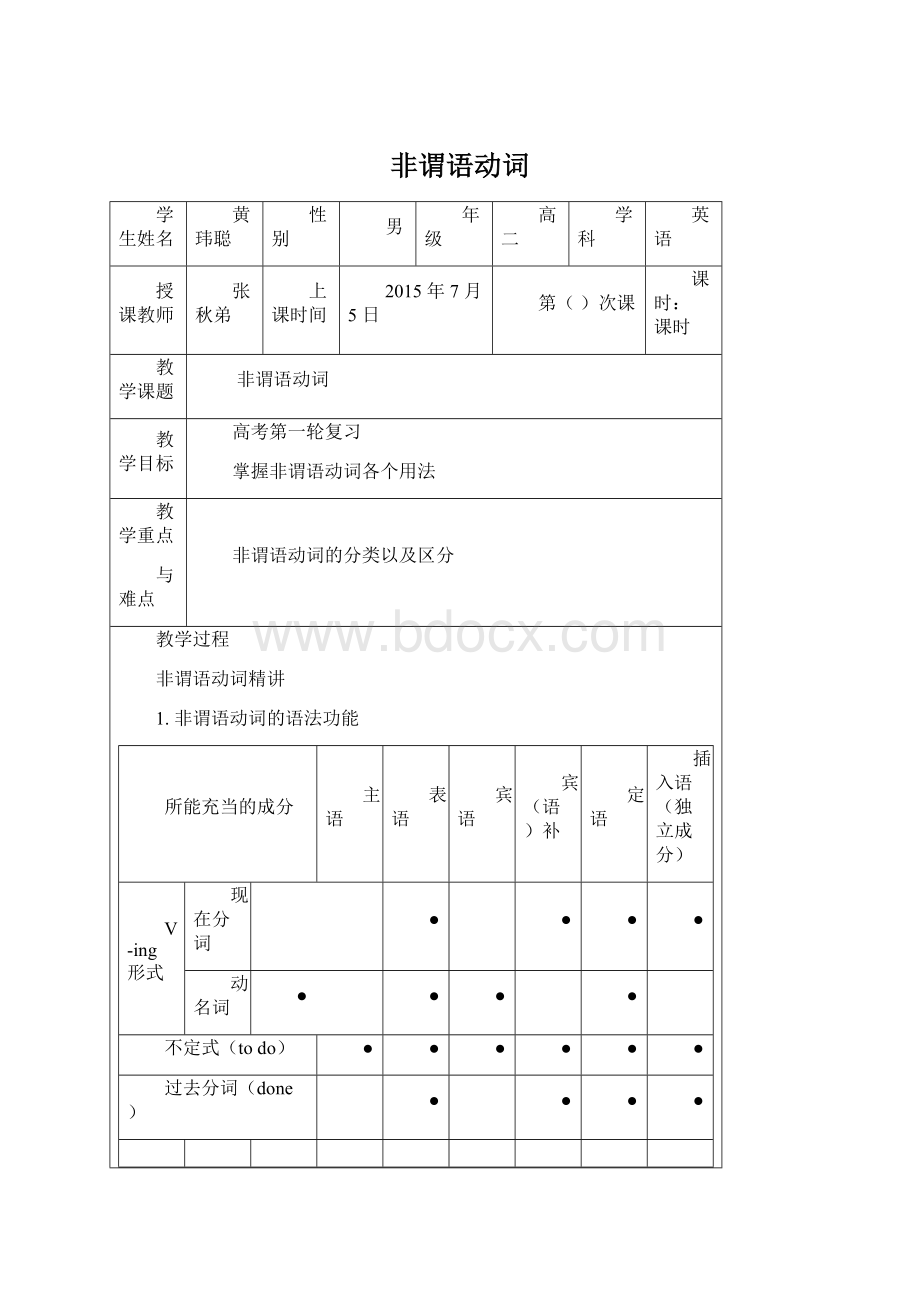非谓语动词Word下载.docx
《非谓语动词Word下载.docx》由会员分享,可在线阅读,更多相关《非谓语动词Word下载.docx(26页珍藏版)》请在冰豆网上搜索。

形式
构成
时态
语态
复合结构
否定式
主动
被动
不定式
一般式
todo
tobedone
forsb.todosth.
或
ofsb.todosth.
在“to”前加not
或never
进行式
tobedoing
/
完成式
tohavedone
tohavebeendone
doing
beingdone
sb.或sb’sdoing
作主语要用
sb’sdoing
在前加not
特别注意复合结构的否定式:
sb’snotdoing
sb’snothavingdone
havingdone
havingbeendone
现在
分词
与动名词变化形式相同
Infinitive(不定式)
不定式的基本形式to-infinitivebare-infinitive
1.作主语
1)不定式做主语一般表示具体的某次动作,尤其是未发生的行为动作。
2)不定式做主语可直接位于句首,但当主语较长时,常用it做形式主语,而将不定式放到谓语的后面。
It
is
important
for
modern
young
people
to
master
at
least
two
foreign
languages.
常见句型结构:
a)
It
is+形容词+不定式It
not
easy
catch
fish
with
your
hands
only.
b)
i+名词+不定式It
us
learn
English
and
it.
c)
takes/needs/requires
(sb.)
some
time
(determination,energy,
patience...)+不定式
takes
me
three
hours
each
day.
2.作宾语
1)不定式作宾语不定式常在下列动词后面作宾语:
afford,agree,aim,apply,appear,arrange,ask,attempt,beg,care,choose,claim,,dare,demand,decide,desire,determine,expect,fail,hope,hesitate,intend,learn,manage,offer,plan,prepare,
pretend,promise,refuse,seek,tend,threaten,want,wish等。
2)在“主语+动词+it+宾补+不定式”结构,it作形式宾语:
We
found
it
impossible
get
everything
ready
in
time.
I
think
well
college.
使用这种句型的常见动词有:
believe,
consider,
declare,
feel,
find,
guess,
imagine,make,
prove,
realize,
suppose,
think,等。
3)不定式一般不作介词宾语,只有少数介词如except,but等后可以跟不定式作宾语.一般情况下作介词宾语的不定式都带to,但如果或所在的句子里有行为动词do,does,did时,常略to.
Wehavenochoicebuttowait.Wecandonothingbutwait.
3.作表语
1)不定式作表语解释说明主语所包含的内容,主语常常是表示意向、打算、计划的词,
如aim,duty,idea,job,policy,purpose,question,suggestion,task,wish等。
The
most
thing
one'
s
health
have
plenty
of
exercise.
My
chief
purpose
has
been
point
out
the
difficulties
matter.
2)作表语的不定式通常都带to,但当主语部分有行为动词do时,to可以省略.
Theonlythingwecandonowiswaitandsee.
4.作定语
1)不定式作定语通常要放在其所修饰的名词或代词之后。
2)不定式作定语的几种情况:
a)表示动作还未发生,被修饰的名词或代词在逻辑关系上是不定式动作的宾语;
Shehasameetingtoattend.
b)被修饰的词是或前面由序数词,形容词最高级或only,
last,
next修饰时,常用不定式作定语。
Mr.
Zhang
always
first
arrive
office
last
leave.
don'
t
he
best
one
do
work.
c)被修饰的名词为抽象名词need,right,way,reason,attempt,ability,determination,decision,promise,plan等时,后常用不定式作定语;
Youhaveeveryrighttofeelbetrayedbyyourfriends.
Thereisnoneedforyoutowaituntilhecomes.
5.作状语
Hespokeloudly(soas/inorder)tobeheard.目的状语.
Theyjumpedwithjoytohearthenews.原因状语.
I’mtootiredtowalkanyfurthertonight.结果状语
Theriverisdangeroustoswimin.方式状语
a)不定式作状语表示目的。
或用于so
as和in
order之后,来强调这种目的。
b)不定式表示结果,特别是在so...as
to,such...as
to,only
to...以及too...to等结构中的不定式表示结果。
e.gI
rushed
station
as
fast
could,
only
find
train
hadalready
gone.
注:
onlytodo常表示意想不到的,令人不快的结果.
c)不定式常用来修饰形容词,构成adj.+不定式:
happy,glad,lucky,fortunate,surprised,angry,anxious,ready,quick,slow,cruel,clever等;
e.g It
likely
rain
today,
very
cloudy.
6.作宾补
1)在“主+动+宾+宾补”的句形中,常用下列动词后带宾语补语:
ask,
advise,
allow,
beg,
cause,
enable,
encourage,
expect,
force,
hear,
have,
inform,invite,
let,
make,
mean,
notice,
order,
permit,
persuade,
remind,
require,request,
teach,
tell,
urge,
watch,
warn,
watch,feel,等。
e.g.He
asked
you
call
him
ten
o'
clock.
2)当不定式在let,make,have,hear,look
at,see,listen
to,feel,observe,watch,notice,perceive(感觉到)等动词后面作宾语补语时,不定式不带to.但在被动结构中宾补变成了主补,此时to要还原.
e,gWhenever
something
wrong
you,
please
let
know.
Hisfathermadehimgotobedearly.Hewasmadetogotobedearlybyhisfather.
注意A.动词不定式的否定式只须在to前加not.Myfatherdecidednottotakeupthejob.
B.带疑问词的动词不定式在to前加疑问词。
Mr.Linwillteachushowtousethecomputer.
C.作简短回答或避免不必要的重复时,动词不定式常省去to后的动词,只保留to。
A:
Wouldyouliketocometomyparty?
B:
Yes,I’dloveto(cometoyourparty).
Marywantedtousemybike,butIaskedhernotto(usemybike).
7.动词不定式(体现时间概念)的三形式
㈠.一般式(todo).Iopenedthedoortoentertheroom.
不定式的一般式所表示的动作(状态)同时(或几乎同时)发生,或之后发生。
㈡.进行式(tobedoing)Whenhismothercamein,hepretendedtobereading.
如果谓语表示的动作(情况)发生时,不定式所表示的动作正进行,则用不定式的进行式。
㈢.完成式(tohavedone)YouseemedtohavereadthenovelwrittenbyMr.Smith.
不定式的完成时表示不定式动词的行为已经发生过了。
8.动词不定式的语态
㈠.主动式(todo/tobedoing/tohavedone)
当不定式逻辑上的主语是不定式所表示的动作的执行者时,用主动式。
WewanttolearnEnglishwell.
㈡.被动式(tobedone/tohavebeendone)
当不定式逻辑上的主语是不定式所表示的动作的承受者时,用被动式。
Hedidn’tliketobelaughedat.
9.用bareinfinitive(省略to的不定式)的几种情况
(1)let,have,make,see,watch,notice,observe,lookat,feel,perceive,listento,hear,etc+O(宾语)+do(不带to的不定式作宾补);
eg.IsawherwalkintotheclassroomandsitdownnexttoMary.
Who/WhomdoyouthinkMr.Whitewillhavewritethereportforhim?
注意:
此句型用于被动语态时,to要还原。
eg.ShewasseentowalkintotheclassroomandsitdownnexttoMary.
(2)有些动词短语和情态动词后要用省略to的不定式,如wouldrather,hadbetter,whynot等;
eg.Ican’twaittoseemybirthdaypresent.I’dbettergoandseeitmyself.
(3)两个或两个以上的动词不定式由and,or,except,but,than,ratherthan,等词连接时,这些词后的动词不定式to的省略;
I’mwillingtogototheofficeandfetchthebookforyou.
(4)不定式作介词宾语时,如果所在句子里有行为动词do,did,does时,to要省略;
eg.Wecandonothingbutwait.
(5)“主+系+表”结构中,如果不定式作表语,主语部分有行为动词do,did,does时,则不定式的to可以省略。
Theonlythingwecandonowiswaitandsee.
10.不定式的主动表示被动的几种情况:
(1)当句子的谓语动词是have,get,find,give,bring等词时,且不定式的逻辑主语就是句子的主语或宾语时,不定式用主动表示被动;
Icanfindnotingtoeatinthefridge.
(2)在too+adj./adv.+todo结构中,不定式用主动表示被动;
eg.Thebookistoodifficulttounderstand.
(3)在enough+todo结构中,不定式用主动表示被动;
eg.Thecaseislightenoughtocarry.
(4)在adj.+todo结构中,如果形容词是difficult,hard,easy,simple,light,heavy等词时,不定式用主动表示被动;
eg.Thebookisdifficulttounderstand.
(5)在with+O(宾语)+todo结构中,不定式用主动表示被动;
eg.Withalotofthingstobuy,Mrs.Blackwentintothesupermarket.
Gerund(动名词)
动名词是非谓动词的一种形式,由动词原形+ing构成。
它既有动词的特征,又有名词的特征,故称动名词。
动名词的句法功能:
动名词主要起名词作用,在句中担任主语、表语、宾语和定语。
1.动名词作主语Walkingisgoodexercise.Playingchessisfun.
---Whywereyousolateforworktoday?
---Drivingtotheofficewasveryslowthismorningbecauseofthetraffic.
动名词作主语,用来表示无时限的泛指动作,或描述当时的。
也可用it作形式主语.但只限于下面句型:
1)动名词在“Itisnouse/nogood/fun/awasteoftime等名词+doing”结构中作主语,it为形式主语。
例如:
Itisnogoodwritingtohim;
heneveranswersletters.
•Itisnousetalkingtoomuch.Itisnotmuchfungoingtoapartyalone.
•Itwouldbeawasteoftimeattemptingtheimpossible.
2)动名词在“Itisuseless/nice/good等词+doing”结构中作主语。
例如:
Itisnicemeetingyou.Itisuselesssendinghimthere.
注意:
此结构句型中的good为名词,意思是“好处”;
而Itisnice+doing结构常于告别时用,等于Itisnicetohavedone,如果刚见面时,则应用Itisnice+todo.
3)动名词在“Thereis(was)no+doing”结构中作主语。
Thereisnodenyingthatsheisveryefficient. Thereisnotellingwhatheisgoingtodo.
2.动名词作表语
动名词作表语起名词作用,用来解释主语的内容,这时动名词和主语的位置是可以交换的。
Thenurse'
sjobislookingafterthepatients.=Lookingafterthepatientsisthenurse'
sjob
动名词和不定式都可以作主语或表语,没有太大区别.在表示经常习惯性动作多用动名词;
在表示具体某次动作,特别是将来的动作时,多用不定式.
Theirjobisbuildinghouses.Ourtasknowistoincreasefoodproduction.
它与谓语动词进行时的区别:
Hishobbyiscollectingstamps.
Heiscollectingstamps.
_____________________________________________________________________________
3.动名词作定语
动名词可作前置定语,表示所修饰的词的用途或目的,可用for改写;
动名词作定语时,动名词和它所修饰的词没有逻辑上的主谓关系.aracingcar=acarforracingaswimmingpool=apoolforswimming
注意动名词和现在分词作定语时的区别:
现在分词作定语用于:
被修饰的名词和做定语的动词为主动关系,该动作正在进行或与谓语动作同时进行,或是经常性行为时。
Thepeoplesittingatthebackmoveforwardplease.(正在进行)
Iliketoliveinthehousefacingthesouth.(经常性的动作)
可用定语从句改写:
asleepingchild=achildwhoissleeping
4.动名词作宾语
1)动名词作动词宾语
①下列动词后只能接动名词:
advise,appreciate,admit(承认),allow,avoid,consider(考虑),delay,enjoy,excuse,escape,finish,forbid,imagine,keep,miss,mind,practice,permit,pardon,resist,recommend,suggest,understand,etc.
•Ican’timaginemarryingagirlofthatsort.Irecommendbuyingthedictionary.
advise/allow/permit/forbid/recommend+doing;
advise/allow/permit/forbid/recommend+sb.+todo.
e.g.Wedoesn’tallowsmokinginthelab.Theteacherdoesn’tallowustosmokeinthelab.
Irecommendbuyingthisdictionary.Irecommendyoutobuythisdictionary.
②有些动词短语后也要求跟动名词作宾语。
常这样用的动词短语有:
putoff,giveup,lookforwardto,feellike,havetrouble/difficulty(in)doingsth.devoteto,getusedto,payattentionto,befondof,stickto,beworth,can’tstand,can’thelp,etc.
e.g.Heputoffmakingadecisiontillhehadmoreinformation.
Doyoufeelliketakingawalk?
2)动名词作介词宾语
注意:
介词后如果需要非谓语动词作宾语,通常只能是动名词,不可用不定式
(except,but除外)
Areyougoodatplayingfootball?
其他介词不易错,重点是介词to.因为不定式符号也是to,所以一定要记住有关的短语.
lookforwardto,devote…to,getusedto,getdownto,contributeto,payattentionto,stickto,onone’swayto…等,这些短语中的to都是介词.
IamusedtowatchingTVintheevening.
We’resomushlookingforwardtoseeingyouagain.
5.动名词与不定式作宾语的区别
★1.有些动词(continue,prefer,begin,hate,like,start,love)后面既可以接不定式作宾语,也可以接动名词作宾语,意义差别不大。
通常认为用动名词泛指一般的倾向性,用不定式则表示特定或具体某一种动作。
e.g.IlikeswimmingbutIdon’tliketoswiminwinter.
★2.有些动词,如forget,remember,regret等接不定式动名词作宾语,二者有别:
后面接动名词表示的动作先于谓语动词动作,不定式表示的动作后于谓语动词。
e.g.Doremembertotellyourmother.Iremembertellingmymother.
Iregrettosay/tellImustleavetomorrow.Iregretnothavi